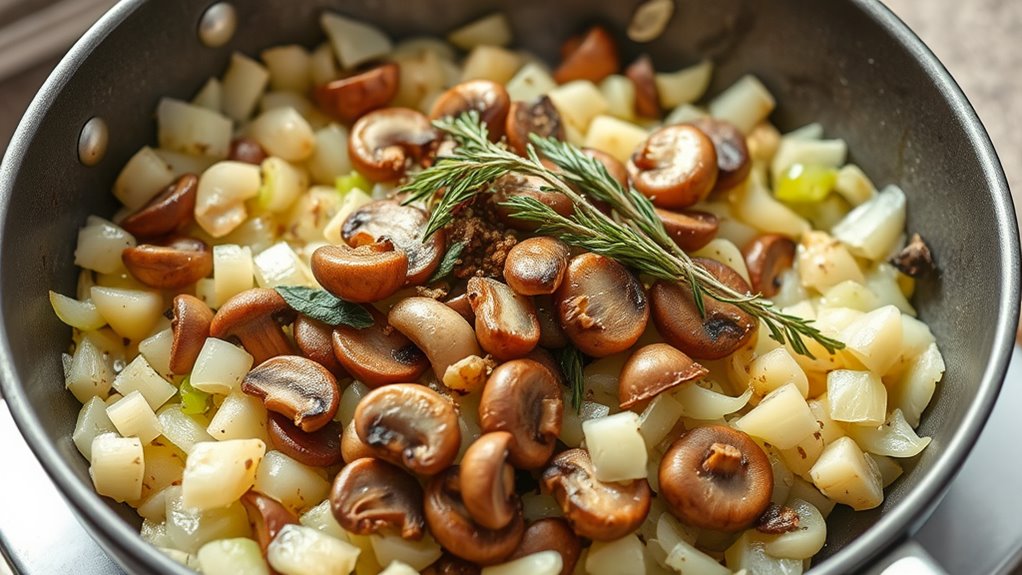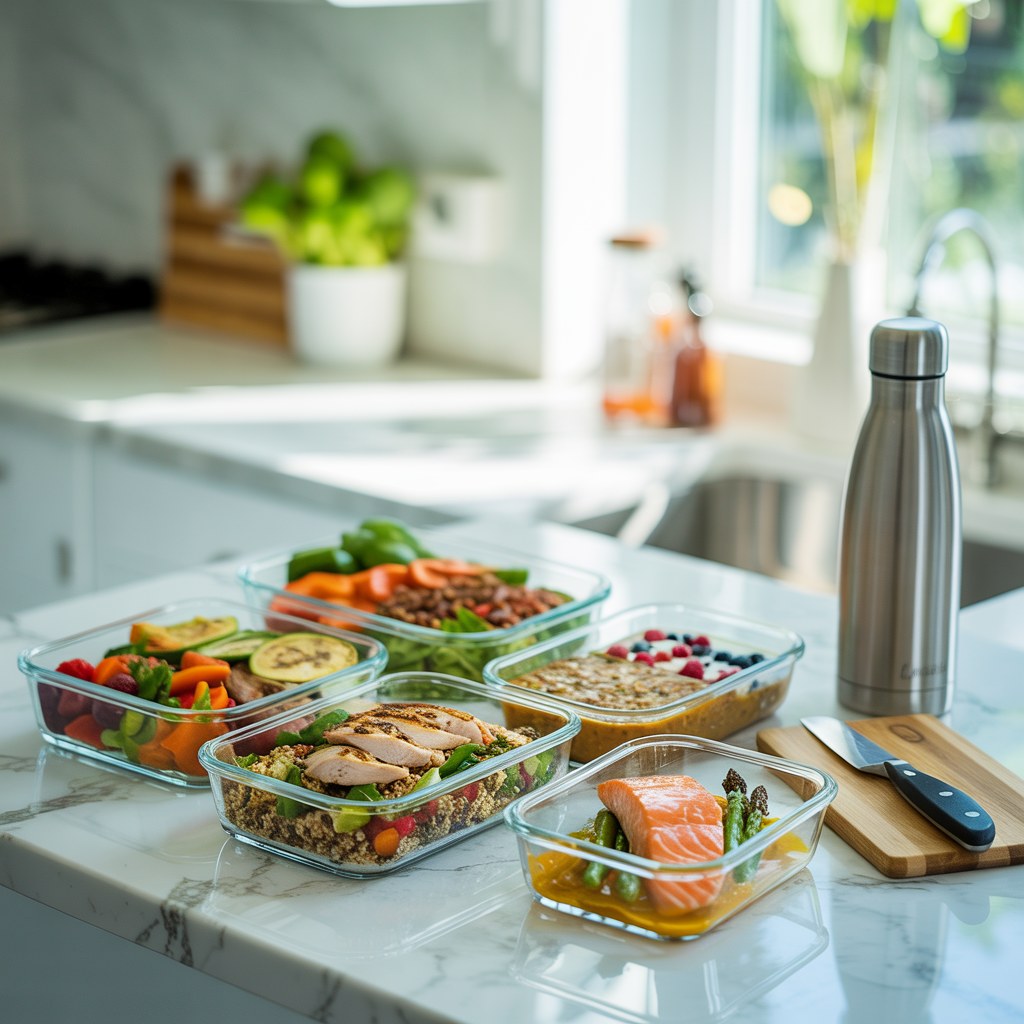Este vegan stuffing combines earthy mushrooms with umami-rich nori seaweed for a plant-based masterpiece. You’ll start with day-old crusty bread soaked in robust mushroom broth, then fold in caramelized aromatics and ground nori. Bake until crispy on top yet tender inside for a dish that satisfies both vegans and omnivores. The careful balance of textures and deep savory profile makes this stuffing versatile enough for holidays or weeknight meals. Discover how centuries-old techniques meet modern plant-based innovation.
Historia
While veganism as we’re aware of it today emerged in the early 20th century, plant-based cooking techniques have existed across cultures for centuries. Figures like Mahatma Gandhi helped popularize vegetarian diets, laying groundwork for the vegan movement that gained significant momentum in the latter half of the 20th century.
Stuffing itself has deep roots in European cuisines, traditionally featuring bread and herbs as core ingredients. As plant-based eating evolved, creative cooks began replacing animal products like butter and meat stock with plant alternatives. The bread preparation process is crucial for vegan stuffing, with properly dried bread ensuring the ideal texture in the final dish. The fusion of traditional methods with innovative ingredients has transformed stuffing recipes over time.
Modern vegan stuffing often incorporates nutritional yeast for cheesy notes and diverse international flavors, reflecting how this holiday classic has adapted while maintaining its role as a cherished centerpiece at family gatherings. With the holiday season approaching, many families are seeking ways to prepare hearty holiday meals without traditional animal-based ingredients. This vegan stuffing recipe features roasted mushrooms that provide a wonderful meaty texture and rich umami flavor.
Receta
Este vegan stuffing transforms traditional holiday fare into a plant-based masterpiece eso sacrifices nothing in flavor or texture. By combining crusty sourdough bread con umami-rich mushrooms y nori seaweed, we create a deeply satisfying dish that delivers complex savory notes without any animal products.
El secret to this exceptional stuffing lies in its layered flavors: a rich mushroom broth, caramelized aromatics, and the unexpected oceanic depth from ground nori. Nutritional yeast adds a subtle cheesy quality that rounds out the flavor profile, while the careful preparation of the bread guarantees it maintains the perfect balance between crisp edges and a tender center eso absorbs the flavorful broth.
Ingredientes:
- 1 large loaf crusty sourdough bread (about 1 pound), torn into 1-inch pieces
- 1 oz dried shiitake mushrooms
- 8 oz fresh cremini or button mushrooms, sliced
- 3 tablespoons extra-virgin olive oil, plus more for drizzling
- 1 large onion, diced
- 3 celery stalks, diced
- 4 garlic cloves, minced
- 2 tablespoons fresh thyme leaves (or 2 teaspoons dried)
- 1 tablespoon fresh sage, chopped (or 1 teaspoon dried)
- 1 tablespoon fresh rosemary, chopped (or 1 teaspoon dried)
- 2 sheets nori seaweed, ground to a fine powder
- 3 tablespoons nutritional yeast
- 2½ cups vegetable broth (plus the mushroom soaking liquid)
- Salt and freshly ground black pepper to taste
- 4 scallions, thinly sliced, for garnish
Begin by preheating your oven to 350°F. Spread the torn bread pieces on a large baking sheet, drizzle with 1 tablespoon olive oil, and season with salt and pepper. Bake for 15-20 minutes until lightly toasted and golden. Meanwhile, place dried shiitake mushrooms in a bowl and cover with 2 cups hot water; let soak for 30 minutes. Once softened, remove the mushrooms, chop them finely (discarding any tough stems), and strain the soaking liquid through a fine-mesh sieve to remove any grit. Reserve this liquid to add to your broth.
In a large skillet, heat the remaining 2 tablespoons olive oil over medium heat. Add onions and celery, cooking until softened, about 5-7 minutes. Add fresh and rehydrated mushrooms and cook until they release their moisture and begin to brown, about 8-10 minutes. Stir in minced garlic, thyme, sage, and rosemary, cooking until fragrant, about 1 minute. For a richer flavor profile, consider using a combination of vegan butter and olive oil when cooking the vegetables. Remove from heat and toss with the toasted bread in a large bowl. Add ground nori, nutritional yeast, and mix thoroughly. Pour in vegetable broth and reserved mushroom liquid gradually, stirring until the bread is moistened but not soggy. Season generously with salt and pepper. Transfer to a greased 9×13-inch baking dish, cover with foil, and bake for 30 minutes. Remove foil and bake for an additional 15-20 minutes until the top is crispy and golden.
For the best texture contrast, confirm your bread is truly dry before adding liquids – stale bread works wonderfully, or you can leave torn pieces out overnight before toasting. If preparing ahead, assemble the stuffing up to the point of baking, refrigerate covered for up to 24 hours, then bring to room temperature before baking. Adding a splash of dry white wine while sautéing the vegetables will enhance their flavor and create additional depth in the finished dish. For extra richness, drizzle with a small amount of olive oil just before serving and garnish with the sliced scallions to add a fresh, bright note to this deeply savory dish.
Pasos de cocción
Start by soaking your torn bread pieces in the rich shiitake mushroom broth, ensuring they absorb flavor without becoming soggy.
Próximo, sauté your mushrooms until thoroughly browned, then add the finely ground nori sheets to introduce that distinctive umami flavor profile.
Finalmente, combine these elements with your sautéed aromatics like onions, celery, and garlic before transferring the mixture to a casserole dish for baking at 375°F until golden and crisp on top. Make sure to cover with foil during baking for the first 30 minutes to lock in moisture before uncovering to achieve that perfect crispy texture.
Step 1. Soak Bread in Broth

The heart of any good stuffing lies in properly soaking your bread cubes in flavorful broth. Pour your warm vegetable broth over your cubed bread gradually, allowing time for absorption between additions. You’ll notice the bread expanding as it drinks in the liquid and flavors.
For this vegan stuffing, pan del día anterior o ligeramente duro works best as it maintains structural integrity while soaking. The crusty exterior absorbs the umami-rich broth while still providing textural contrast. This technique follows a tradition that spans across cultures, where bread soups and stuffings have been created as ways to repurpose stale bread for centuries. Similar to Bavarian brotsuppe, this method transforms seemingly unusable bread into something delicious and satisfying. Make sure your broth is well-seasoned with herbs that complement the mushrooms and nori. This approach resembles historical recipes where bread soaked in broth formed the foundation of hearty soups such as Purslain Soup.
Don’t oversoak—you’re aiming for bread that’s moist throughout but not soggy. The bread should hold its shape when gently pressed but feel tender. Just like making traditional bread with bone broth, this careful soaking process creates the foundation for a stuffing that’s flavor-packed and perfectly textured.
Sauté Mushrooms Thoroughly

Properly sautéed mushrooms form the backbone of this vegan stuffing, delivering deep umami flavor that complements the oceanic notes of nori.
Preheat your skillet for a few minutes, then add equal parts butter substitute and oil (about 1 tablespoon each per 10 oz mushrooms). Once the oil shimmers, add your ¼-inch sliced mushrooms in a single layer. Let them cook undisturbed for 3-6 minutes until one side browns.
Don’t stir frequently during this initial phase. As moisture releases, you’ll hear the sound change from sizzling to bubbling. After the liquid evaporates, stir more often (every 15-30 seconds) until mushrooms develop golden-brown edges—about 5-6 minutes more. When working with certain varieties, you may need to adjust the heat if your mushrooms aren’t releasing liquid as expected. For best results, avoid overcrowding the pan as this will cause mushrooms to steam rather than properly brown.
Add salt midway through cooking, then incorporate garlic during the final 1-2 minutes. Consider adding minced shallots halfway through the cooking process for additional flavor complexity. Remember that patience is required to achieve perfectly tender, buttery mushrooms rather than rubbery, slimy ones. This thorough sautéing concentrates flavor and prevents soggy stuffing.
Step 3. Add Crumbled Nori Sheets

Introducing crumbled nori sheets elevates this vegan stuffing from ordinary to extraordinary. After your mushrooms are nicely browned, briefly toast 2 sheets of nori over an open flame for 10-20 seconds until they curl and turn golden-brown. Let them cool completely before handling.
Crumble the toasted nori by hand into small, irregular pieces—avoid food processors as they won’t break down properly. Add the crumbled nori to your mushroom mixture, stirring to distribute evenly throughout. The nori will infuse your stuffing with savory umami notes and subtle oceanic complexity without overpowering other ingredients. For an extra layer of flavor, sprinkle with salt immediately after toasting the nori sheets. The high vitamin and mineral content of nori adds nutritional benefits to your stuffing, including vitamins A, K, C, and B. This approach creates a similar effect to using kizami nori, which is traditionally used as a topping to add a distinctive sea flavor to dishes.
For best results, incorporate the nori after sautéing but before adding bread cubes. This guarantees the delicate seaweed maintains its texture while its flavor compounds fully integrate with the aromatics. The nori will keep its distinctive taste when stored in an recipiente hermético in the refrigerator for up to 2 weeks.
Step 4. Combine With Aromatics

Creating a flavorful aromatic base forms the foundation of exceptional vegan stuffing. Begin by heating olive oil or vegan butter in a preheated skillet over medium heat until shimmering. Add finely diced onions and celery, sautéing for about 5 minutes until translucent and soft, stirring occasionally to prevent burning.
Once your base vegetables have softened, add smashed and chopped garlic, cooking for another 3-5 minutes until golden brown. Next, incorporate your quartered mushrooms, cooking for 8-10 minutes until they shrink and begin to brown, developing their meaty texture and umami depth.
Season with dried herbs like thyme, sage, and rosemary along with salt and pepper. For additional savory notes, consider adding nutritional yeast. Finally, fold in your prepared nori sheets to distribute their oceanic umami throughout the aromatic mixture.
Step 5. Step 5{optimize_title]

After your aromáticos have fully developed their flavors, it’s time to combine all components into a cohesive stuffing. Transfer your crisp bread pieces to a large bowl and mix in the sautéed mushrooms, including all those flavorful browned bits scraped from the pan.
Pour in the remaining shiitake broth and sprinkle the ground nori throughout the mixture, ensuring everything is evenly moistened but not soggy. Then, transfer your stuffing to a casserole dish and bake at 375°F until golden on top and steamy throughout.
Once finished, drizzle with olive oil and garnish with fresh scallions before serving. You can prepare this stuffing up to a day ahead and reheat when needed. Leftovers keep well for up to a week refrigerated, or you can freeze portions for longer storage.
Reflexiones finales
Vegan stuffing with mushrooms and nori transforms the traditional side dish into a umami-packed culinary masterpiece. This reinvention combines earthy shiitake mushrooms, briny nori, and cheesy nutritional yeast to create depth that rivals any meat-based version.
You’ll appreciate how the crispy bread cubes offer textural contrast while soaking up the savory flavors. Whether you’re hosting Thanksgiving dinner or looking for a hearty winter side, this versatile dish complements your menu beautifully.
Don’t be afraid to make it your own—add sweet potatoes for sweetness or chickpeas for protein. The health benefits are notable too, with fiber-rich ingredients and antioxidant-packed herbs. When properly baked at 375°F, you’ll achieve that perfect balance of moisture inside and crispness on top that’ll have everyone reaching for seconds.
Preguntas frecuentes
Can I Make This Stuffing Ahead of Time?
Yes, you can make stuffing ahead of time! Prepare it up to 3 days in advance and refrigerate, or assemble and freeze it unbaked. Toast bread cubes a week ahead, and sauté vegetables 2-3 days before.
For best results, store components separately and combine just before baking. When reheating, cover with foil and add a splash of broth if needed. Remove foil during the last 10 minutes for a crispy top.
What Can I Substitute for Nori?
Para nori substitutes, you’ve got several options. Try dulse flakes for similar umami flavor, or sprinkle toasted sesame seeds for nuttiness and crunch. Furikake seasoning works well too.
If you need structure, use soy paper or rice paper instead. Kale chips crushed into flakes can mimic the texture while adding nutrients.
For stuffing specifically, kombu can infuse broths with that sea-like flavor before you remove it. Each alternative brings different qualities to your dish.
How Long Will Leftover Vegan Stuffing Last?
Your leftover vegan stuffing will last 3-5 days when stored properly in the refrigerator at 40°F or below. Be sure to refrigerate it within two hours of cooking in an airtight container.
If you want to extend its shelf life, you can freeze it for up to 3 months. Always check for signs of spoilage like an off smell or visible mold before consuming, regardless of storage time.
Is There a Gluten-Free Version of This Recipe?
Yes, you can easily make a gluten-free version of this recipe! Use gluten-free bread as your base, and verify your vegetable broth is gluten-free. Dry the bread thoroughly before use to prevent sogginess, and bake croutons ahead for extra crispness.
The nori and mushrooms are naturally gluten-free. For best results, cover while baking then uncover at the end for a crispy top. You’ll need to adjust moisture levels slightly for gluten-free bread.
Can I Freeze This Stuffing Before or After Cooking?
Puede freeze this stuffing both before or after cooking with good results. If freezing before baking, assemble everything in a baking dish, cover tightly, and freeze for up to 3-6 months.
If freezing after baking, cool completely first. When you’re ready to use pre-baked stuffing, thaw overnight in the fridge and bake as normal. For cooked stuffing, reheat covered at 350°F for 15-30 minutes, adding a splash of broth if it seems dry.
Referencias
- https://www.richroll.com/blog/plantpower-holiday-cooking-how-to-make-gluten-free-vegan-stuffing/
- https://www.youtube.com/watch?v=lGZ4WeRtDw4
- https://munchmealsbyjanet.com/2020/11/05/vegan-stuffing-with-mushrooms/
- https://rainbowplantlife.com/vegan-thanksgiving-mushroom-stuffing/
- https://cookingforpeanuts.com/vegan-stuffing-recipe/
- https://www.kamachorecipes.com/vegan-stuffing-with-mushrooms-nori/
- https://in.pinterest.com/pin/464715255317327010/
- https://www.veggieinspired.com/vegan-stuffing-mushrooms/
- https://milpreps.com/recipe/vegan-stuffing-with-mushrooms-nori/
- https://cookingwithjade.com/flavorful-vegan-stuffing-recipe/
- https://tastecooking.com/broth-eggs-stale-bread/
- https://shadygroveranch.grazecart.com/recipes/broth-bread
- https://en.julskitchen.com/first-course/soup/brotsuppe-bavarian-bread-soup
- https://hearttohearthcookery.com/2020/08/19/bread-soaked-in-broth-a-taste-of-hearth-cooking/
- https://veggiesociety.com/italian-bread-soup-recipe-pappa-al-pomodoro/
- https://naturalcomfortkitchen.com/how-to-saute-mushrooms/
- https://www.bowlofdelicious.com/sauteed-mushrooms/
- https://tastesbetterfromscratch.com/how-to-saute-mushrooms/
- https://oursaltykitchen.com/how-to-saute-mushrooms/
- https://www.foodandwine.com/news/nori-cooking-tips










